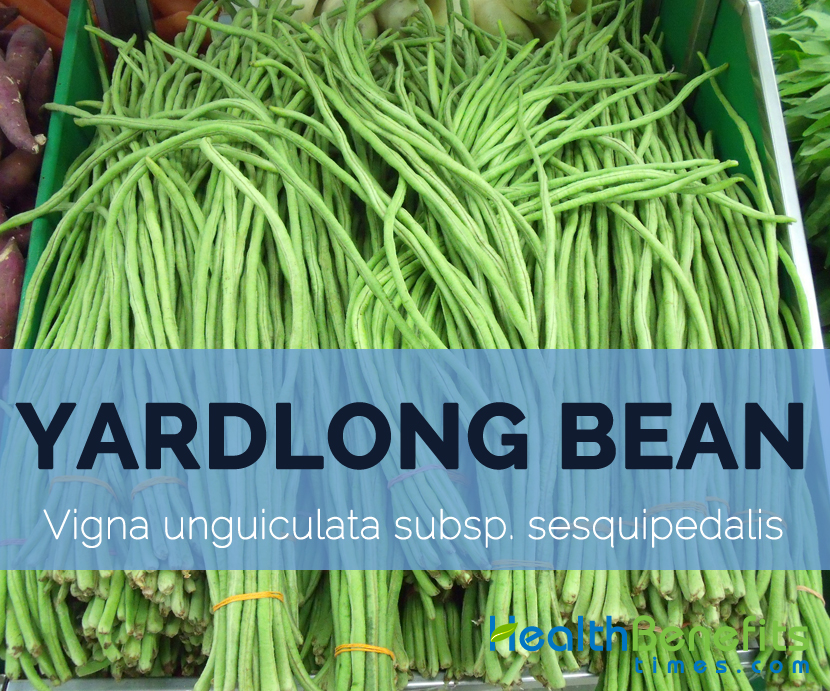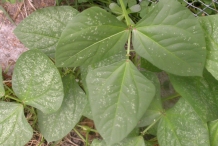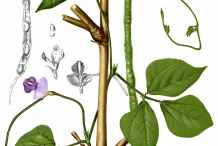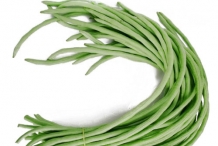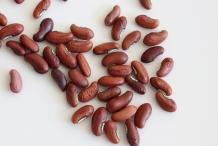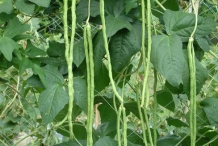Yardlong bean was originated in Southern Asia but now it is widely cultivated in Southeastern Asia, Southern China and Thailand. It grows in warm climates. Leaves are consumed as vegetables, young pods are cooked or consumed fresh and seeds are cooked as a pulse. The pods are picked before it gets matured and cooked as vegetables.
Plant
The Yardlong bean plant grows as an annual, glaborous climber which reaches 2–4 m in height. It bears bright green, trifoliolate leaves each 12–15 cm long and 4–7 cm wide. The plant yields white, yellow or light purple flowers. The flower turns into pendulous pods which is typically 30–100 cm long. The pod color varies from light green to dark green or purple having smooth, rugose or crinkled skin. Each pod possesses 20-25 seeds. The seeds are elongated, cylindrical or round upto 8–12 mm long which ranges from black, brown, red, striped, white or mottled colors. The pods are harvested from mid to late summer.
Nutritional Value
In a serving size of 100 grams of yard-long beans there are 47 calories, 4 mg sodium (0% daily value), 8 grams of total carbohydrates (2% daily value), and 3 grams of protein (5% daily value) with no total fat and no cholesterol.
Health Benefits of Yardlong beans
Yardlong beans are loaded with antioxidant, antibacterial, antiviral and anticancer properties. It contains beta-carotene, Vitamin B1 and B2, chlorophyll, riboflavin, protein, phosphorus, thiamine, fiber, iron, and pectin. It is low in calories. It provides an adequate of minerals such as copper, calcium, iron, manganese and magnesium.
- Skin health
The study shows that those who intake high amount of Vitamin C, it reduce the appearance of wrinkles, skin dryness and slows down the aging process. Vitamin C is essential for the skin, ligaments, blood vessels and tendons. It speeds up the healing process.
Some evidences shows that the skin cream which is high in Vitamin C reduces the skin redness. The diet which is rich in antioxidants helps to prevent the skin cancer as well.
- Lowers risk of Gout
As Yardlong are rich in Vitamin C, it also lowers the risk of gout which is painful condition that afflicts big toe. It is caused due to the high uric acid that forms crystals in joints. In the study, those who intake 1000-1499 mg of Vitamin C, their chances of gout was decreased by 31%.
- Eliminates free radicals
Vitamin C is an antioxidant that prevents the damage of free radicals, pollutants and toxic chemicals. The buildup of free radicals results the health ailments such as heart disease, cancer and arthritis. The free radicals are created during the breaking down of food or when exposed to tobacco, smoke or radiation.
- Cancer prevention
The deficiency of folate increase the chances of colon, breast, cervical, lung and brain cancer. The evidences show that the intake of foods rich in folate prevents the cancer development.
The study shows that those who intake 900 micrograms of folate daily, their chances of colorectal cancer was reduced by 30%.
- Healthy heart
Folate assist to lower the homocysteine which is the protein build up that increase the chances of stroke and heart attacks. Those who intake high amount of folate, it helps to reduce the chances of cardiovascular disease. It reduces the risk of heart disease by improving the cardiovascular health.
- Sound sleep
The magnesium deficiency is the cause for the sleep disorders such as hyperactivity, anxiety and restlessness. Magnesium is essential for the GABA function that soothes brain and enhances relaxation. Yardlong provides an adequate amount of magnesium which treats the sleep disorders effectively.
- Healthy pregnancy
During pregnancy, an adequate amount of food rich in folate helps to lower the chances of neural tube defects such as anencephaly and spina bifida. The birth defects such as limb and heart malformations are the result of folate deficiency. Folate is vital for the replication of DNA and the proper growth of fetus cells. It is essential in order to have a healthy pregnancy. The foods rich in folate reduce the chances of neural tube defects by 26%.
- Enhance immunity
Thiamine tones the wall muscles of the digestive tract. Thiamine assists in hydrochloric acid secretion that is required for the food particle digestion and nutrient absorption. The healthy digestion assist to absorb the nutrients properly.
- Eye health
Some research has shown that thiamine can help to defend against vision problems such as cataracts and glaucoma. This is due to its ability to influence nerve and muscle signaling, which is important in relaying information from the eyes to the brain.
Yardlong bean – Vigna unguiculata subsp. sesquipedalis Facts
Yardlong Bean is a vigorous climbing plant which produces long pods of about 14-30 inches within 60 days of sowing. The pods are picked before it is matured for vegetable uses. The pods are tender crisp and delicious. It is cooked like other green beans by cutting it into shorter sections.
| Yardlong bean Quick Facts | |
|---|---|
| Name: | Yardlong bean |
| Scientific Name: | Vigna unguiculata subsp. sesquipedalis |
| Origin | Southern Asia and is widely grown in Southeastern Asia, Southern China and Thailand |
| Colors | Light green-dark green or purple |
| Shapes | Pendulous; Length: 30–100 cm |
| Calories | 43 Kcal./cup |
| Major nutrients | Vitamin C (19.00%) Vitamin B9 (14.00%) Magnesium (9.52%) Isoleucine (8.13%) Manganese (8.13%) |
| Health benefits | Skin health, Cancer prevention, Healthy heart , Sound sleep, Healthy pregnancy |
| Name | Yardlong bean |
|---|---|
| Scientific Name | Vigna unguiculata subsp. sesquipedalis |
| Native | Yardlong bean was originated in Southern Asia and is widely grown in Southeastern Asia, Southern China and Thailand. |
| Common/English Name | Asparagus Bean, Chinese Long Bean, Bodi Bean, Green Asparagus Bean, Green Podded Cow Pea, Garter Bean, Long Horn Bean, Long Bean, Long Podded Kidney Bean, Long Podded Cowpea, String Bean, Snake Bean, Yard-Long Cowpea, Yard Long Bean |
| Name in Other Languages | Arabic: Lûbyâ’ Baladî; Chinese: Cai Dou; Danish: Aspargesbønne; Ethiopia: Adenguare; French: Dolique Asperge; German: Langbohne; Hmong: Taao-Hla-Chao; India:- Bengali: Borboti, Goa: Eeril, Tamil: Karamani; Italian: Fagiolo Asparago; Indonesia: Kacang Belut; Japanese: Furou Mame; Khmer: Sândaèk Troeung; Malaysia: Kacang Panjang; Philippines:– Iloko: Utong, Tagalog: Sitao, Visaya: Banor; Portugal: Dólico Gigante; Russian: Boby Sparzhevye; Spanish: Dólico Gigante; Thai: Tua Fak Yaow; Vietnamese: Dâu Dûa; West Indies: Bora; |
| Plant Growth Habit | Annual, glabrous climber, fast growing |
| Growing Climate | Warm climate |
| Soil | Well drained |
| Plant Size | 2–4 m |
| Root | Strong tap root system |
| Leaf color | Bright green |
| Leaf shape and size | Trifoliolate; Length: 12–15 cm; Width: 4–7 cm |
| Edible parts of the plants | Young pods: The young pods are consumed fresh or cooked. Young tender shoots and leaves: The young shoot and leaves are eaten as vegetables after it is steamed or boiled. Seeds: The seeds are stored, dried and cooked as a pulse. It is also soaked and used as bean sprouts. |
| Flowering Season | Mid-summer |
| Flower | White, yellow or light purple |
| Pod shape & size | Pendulous; Length: 30–100 cm |
| Pod color | Light green-dark green or purple |
| Pod peel | Smooth, rugose, crinkled |
| Seed shape & size | Elongated, cylindrical or round, Length: 8–12 mm |
| Seed color | Black, brown, red, striped, white, mottled |
| Flavor/aroma | Delicate, intense, sweet |
| Varieties/Types |
|
| Harvest Season | Mid-late summer |
| Major Nutritions (Raw pods) | Vitamin C (Ascorbic acid) 17.1 mg (19.00%) Vitamin B9 (Folate) 56 µg (14.00%) Magnesium, Mg 40 mg (9.52%) Isoleucine 0.136 g (8.13%) Manganese, Mn 0.187 mg (8.13%) Vitamin B1 (Thiamin) 0.097 mg (8.08%) Phosphorus, P 54 mg (7.71%) Vitamin B2 (Riboflavin) 0.1 mg (7.69%) Valine 0.147 g (6.96%) Histidine 0.082 g (6.66%) |
| Health Benefits |
|
| Calories in 1 cup (91 gm) Raw pods | 43 Kcal. |
| Precautions | The people with favism and immune allergy to legumes should avoid the consumption of Yardlong beans. |
| How to Eat |
|
Comments
comments
